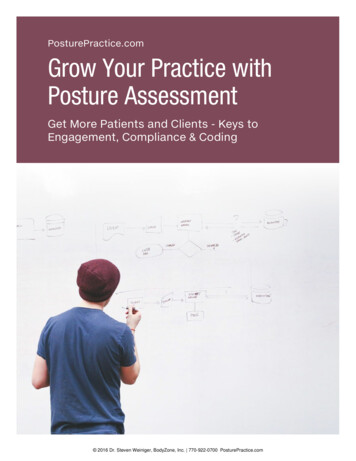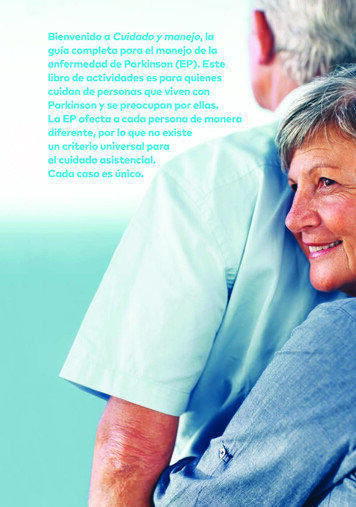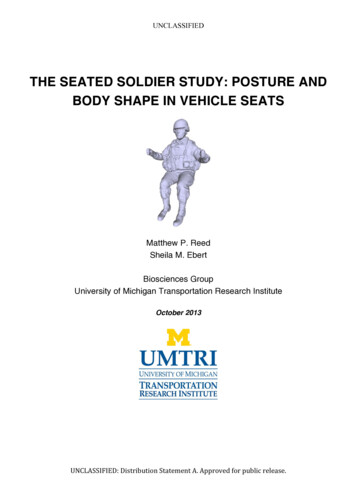
Transcription
8SEATING AND POSTURE ISSUES– POSSIBLE SOLUTIONSThis chapter includes additional informationfor professionals who prescribe wheelchairs,about the needs of users with neuromuscularconditions.It should be read in conjunction with chapters6 and 7 which detail the clinical reasoning forthe solutions suggested here.Dealers and representatives of assistivetechnology companies who provide equipmentdemonstrations and/or help with provisionshould be made aware of the clinical issues inthe long-term management of neuromuscularconditions. Collaboration between the assistivetechnology provider and the therapist canproduce the best outcome for a user.Seating and posture issues – possiblesolutions 67The Environment
PELVIS AND HIPSPOSTURAL ISSUE AETIOLOGY,EFFECTS AND ASSESSMENTWHEELCHAIR AND SEATING EQUIPMENTAnterior pelvic tilt (APT)n Tight hip flexorsRegularly check the position of the pelvis so anychanges can be quickly detected.n User finding it a stable positionManagement will depend on whether the APTis fixed or correctable.Effects:The following are possible solutions and eitherone, or a combination, may help.Aetiology:n Weak musclesAPT causes increase in the lumbarlordosis and reduces the functionalreach of a user (more so than aposterior pelvic tilt).Solutions:1. A good quality, tension adjustable backcanvas with many narrow straps whichcan be adjusted to encourage ‘softening’of excessive lordosis. A standard back canvasis inappropriate2. Create a rearward sloping seat and carefullyset up the back angle to reduce the tendencyto lumbar lordosisAssessment:By height discrepancy, with ASISslower than PSISs3. Using an adapted tray to form an anteriorsupport for the trunk is often very effectiveand functional for the user4. Padded pelvic positioning accessories(i.e. belts, straps and harnesses) can be usedbut need to be tight to be effective and are,therefore, not always well tolerated5. Open the hip angle by altering the seat angleor using the recline function. Be careful notto cause the pelvis to slide forwards6. Tilt-in-space is very beneficialModifications to posture and position are bestdone in small incremental changes as theseallow the user to physiologically adapt to them68Seating and posture issues – possible solutions
PELVIS AND HIPSPOSTURAL ISSUE AETIOLOGY,EFFECTS AND ASSESSMENTWHEELCHAIR AND SEATING EQUIPMENTPelvic obliquityAetiology:n Muscle weakness(including headand neck)n Effectsof gravityn Asymmetricposturesn Poor seatingEffects:n Asymmetrical posture anddetrimental effect on sittingbalancen Asymmetrical weight bearing,increasing risk of tissuebreakdownn Physiological implicationsinclude restricted respiration,digestionAssessment:Palpate the ASISs and check fora height discrepancy betweenthem. Record any obliquity andassociated spinal scoliosis so itcan be monitored. With anyobliquity there is nearly always acompensatory scoliosis. To assessa scoliosis, palpate the spinusprocesses along the length of thespine. If taking photographs, itmay help to stick coloured paperdots over the processes.It is also worth checking forrotation which will display as oneASIS being posterior/anterior tothe other.Regularly check the position of the pelvisso any changes can be quickly detected.Management will depend on whether thepelvic obliquity is fixed or correctable.Contributing factors may be:n seat is too widen arm supports are set too far apart or too lown worn, sagging seat upholstery and/orunsuitable foam cushionn incorrect orientation/use of a specialistcushion (unstable laterally)n insufficient trunk support, causing userto lean more to one armrest for additionalsupportn unilateral joystickSolutions:1. Ensure correct seat dimensions, arm supportpositioning etc2. Ensure a level base of support for the cushion3. Provide appropriate cushion and ensurecorrect usage4. If obliquity is flexible, use a specialist cushionto correct5. If the obliquity is fixed, compensate bybuilding up the high side and/or lowering thelow side to even out contact area throughoutthe cushion6. Ensure sufficient trunk support for levelof disability and prescribe proactively7. Consider alternative position forjoystick/specialist controlSeating and posture issues – possible solutions69
PELVIS AND HIPSPOSTURAL ISSUE AETIOLOGY,EFFECTS AND ASSESSMENTWHEELCHAIR AND SEATING EQUIPMENTPelvic rotationAetiology:Regularly check for any spinal/pelvic rotationand deal with it quickly before it becomes fixed.Management will depend on whether thepelvic rotation is fixed or flexible.Using contoured cushions and back supportsat an early stage reminds the user to stay in aneutral/symmetrical sitting position.Wind-sweeping of femurs may also occur.The rotational deformity of thepelvis originates from the spine.When attempting to correct at thepelvis ensure you are not shiftingthe problem up to, for example,the shoulder girdleEffect:Apparent discrepancy betweenleg lengths due to pelvic rotation.Assessment:Rotation can be assessed bypalpating the ASISs. Rotationis indicated when one ASIS isposterior/anterior to the other.A different degree of rotation maybe seen at the shoulder girdle andshould also be assessed.70Monitor and provide the necessary supportto prevent abnormal compensatory posturesbeing adopted by the user to gain the desiredtrunk stability.Solutions:1. Check dimensions of chair and components.A chair that is too wide, for example, canfacilitate pelvic rotation2. Contoured cushions with good leg troughs3. Appropriate lower back support is preferableto a canvas back which may mould to therotated pelvis4. Padded belts5. Sub-ASIS bars6. Other hip stabilising devices7. Appropriate trunk support (see aetiology)Seating and posture issues – possible solutions
HIPS, KNEES AND FEETPOSTURAL ISSUE AETIOLOGY,EFFECTS AND ASSESSMENTWHEELCHAIR AND SEATING EQUIPMENTMisalignment of femursAetiology:Solutions:Wind-sweeping of thighs oftenassociated with pelvic/spinalrotation obliquity or hipsabducted and externally rotated1. Hip and thigh guides are helpfulAssessment:In a supine position. Takingphotographs is recommended asmeasurements can be complex forthis posture2. Adductor/abductor wedges on a cushion/system3. Contoured cushion that provides leg troughs4. Padded leg strapsFlexion contractures at hips occur at an early stage, even in users whoare ambulantAetiology:n Muscle weaknessn Loss of elastin in muscle fibren Shortened hamstringsn Weak proximal musclesAssessment:With goniometerPrevention of hip contractures are not theprincipal concern for users – often with ananterior tilted pelvis – who are more stablesitting with a closed hip angle (i.e. less than90 degrees between back and seat).Therapeutic standing and use of the reclinefunction on a wheelchair can help maintaina range of movement in the hip. Physiotherapyis also vital.Consider bone density when prescribinga wheelchair with a standing function. Testsmay be needed before using such a wheelchair,particularly if the user has not been weightbearing for some time or has used/is currentlyusing steroids.Seating and posture issues – possible solutions71
HIPS, KNEES AND FEETPOSTURAL ISSUE AETIOLOGY,EFFECTS AND ASSESSMENTWHEELCHAIR AND SEATING EQUIPMENTFlexion contractures at the knees usually occur once an individual becomes awheelchair userAetiology:n Muscle weaknessn Loss of elastin in muscle fibren Shortened hamstringsn Weak proximal musclesRegular monitoring of a user’s range ofmovement can help to identify flexioncontractures at an early stage.Any management programme should includephysiotherapy. Surgery may be required insome cases.Assessment:With goniometerSolutions/management1. Determine whether stretching is appropriatewith articulating leg supports (with leglength compensation)2. If stretching is not appropriate, selectappropriate hanger angle for the rangeof movement e.g. 70, 85 or 90 degrees. Thismight necessitate a change of wheelchair3. Some footplates can be adjusted forwardsand aft (anterior/posterior)4. Examine the effect of heel and calf straps.Note the pressure exerted by the strapson soft tissues and check for sores/ulcers5. To avoid compromising posture, considercushions with calf recesses or customisinga cushion. Otherwise, seat depth will needto be shortened which will reduce the surfacearea of the cushion/seat in contact withthe calves and increase the risk of skinbreakdown. Pressure needs should bere-evaluated72Seating and posture issues – possible solutions
HIPS, KNEES AND FEETPOSTURAL ISSUE AETIOLOGY,EFFECTS AND ASSESSMENTWHEELCHAIR AND SEATING EQUIPMENTPlantar flexion with or without inversion of feet and anklesSolutions/management:1. Angle-adjustable footplates(anterior/posterior and medial/lateral)2. Correct size/shape footplates3. Padded foot box may be needed to protectfeet4. Ankle huggers5. Check user does not place heel on topof heel strap so positioning the ankle inplantar flexionConsider the impact of the above on transfersand independenceDiscomfort and pressure issuesMost users spend many hours in theirwheelchairs. They have full sensation butare often unable to change positionindependently or effectively. A suitablehigh-pressure redistribution cushion usedwith the tilt-in-space function can promoteskin integrity and help users independentlymaintain comfortSeating and posture issues – possible solutions73
SPINEPOSTURAL ISSUE AETIOLOGY,EFFECTS AND ASSESSMENTWHEELCHAIR AND SEATING EQUIPMENTScoliosis with/without rotationAetiology:n Muscle weaknessn Seeking external sourcesof supportn Activity basedAssessment:PhotographyIt is impossible to prevent scoliosis throughwheelchair seating alone. Lateral support viathoracics/thoracic pads/laterals will assist,but the condition should be managed by amultidisciplinary team. Stay in regular contactwith this team to ascertain what managementstrategy they propose (e.g. spinal jackets,surgery), as this will significantly influencethe wheelchair and seating prescription.Some users find harnesses give them moreconfidence and trunk stability when they areout and about, particularly in vehicles or whennegotiating uneven ground, slopes and ramps.Scoliosis can be managed in the early stageswith 2-point, usually symmetrical, contact. If thecondition is more advanced it may be necessaryto use 3-point contact (see chapter 6). Check forpressure areas and add extra padding/gel orincrease the surface area if necessary.Swing-away laterals significantly help withtransfers and some activities of daily living.The 3D profile of the back is also importantand should encourage the maintence of thenatural curves of the spine.Respiration can also be affected by scoliosis.74Seating and posture issues – possible solutions
SPINEPOSTURAL ISSUE AETIOLOGY,EFFECTS AND ASSESSMENTWHEELCHAIR AND SEATING EQUIPMENTExcessive lumbar lordosis associated with anterior tilted pelvis.n Muscle weaknessThe following are possible solutions and eitherone, or a combination, may help:n Activity based1. A good quality, tension adjustable back slingwith many narrow straps which can beadjusted to encourage ‘softening’ of excessivelordosis. A standard back sling is inappropriateAetiology:n Seeking external sourcesof supportAssessment:Photography2. Create a rearward sloping seat and carefullyset up the back angle to reduce the tendencyto lumbar lordosis3. Using an adapted tray to form an anteriorsupport for the trunk is often very effectiveand functional for the user4. Padded pelvic positioning accessories(i.e. belts, straps and harnesses) can be usedbut need to be tight to be effective and are,therefore, not always well tolerated5. Open the hip angle by altering the seat angleor using the recline function. Be careful notto cause the pelvis to slide forwards6. Tilt-in-space is very beneficialSmall incremental changes to posture and position are best as these allow the user tophysiologically adapt to them.The most effective solution is to encourage some posterior pelvic tilt using the tilt-in-spacefunction with, or without, recline. The degree of tilt is crucial. This can be assessed bymanually tilting the user in his or her wheelchair to see at what angle the tilt becomeseffective. At least two members of staff are required for this. The head and arms shouldbe supported to stop the arms falling off the armrests while tilting, preventing the userfrom accessing the controls.‘Filling in’ the lumbar gap is rarely effective and can push the lordotic spine into furtherhyperextensionSeating and posture issues – possible solutions75
NECKPOSTURAL ISSUE AETIOLOGY,EFFECTS AND ASSESSMENTWHEELCHAIR AND SEATING EQUIPMENTWeak head and neck controlAetiology:n Muscle weaknessn Exacerbated by poor trunkposturen Poor head control with tilt-inspace and no head supportA finely adjusted degree of recline and/or tiltin-space with head support can help if theuser’s head is falling forwards or to rest weakneck muscles during the day. Some users,however, may need to be fully supported at alltimes. While profiled head supports that givegood contact and support are generally welltolerated, some do make the user feel tooenclosed or restrict hearing. More minimal headsupports are available.Assessment:n Physical assessmentn Simulation of different trunkangles to balance head betterThis image is the propertyof Otto Bock Healthcare PlcVery rarely and as a last resort, headbands areused to support the head anteriorly. These mustbe used exceedingly carefully for safety reasons.It is essential that these are secured to preventthe band falling down over the face and/orneck. There is also concern about subluxationof the cervical spine.Where users have this level of disability,specialist controls are often required. Ensurethat the head support is compatible with thecontrols to be used now and in the future.A simple head support is enough if the useronly requires support when being transported.76Seating and posture issues – possible solutions
NECKPOSTURAL ISSUE AETIOLOGY,EFFECTS AND ASSESSMENTWHEELCHAIR AND SEATING EQUIPMENTA spine which has been fused surgically is usually fixed from cervical to lumbarspine and may not include the pelvis. The fusion may include the pelvis.n Fused spine and possibly withpelvic inclusionAscertain level of spinal fusion and whether thepelvis is included.Effects:Solutions and management will depend on theseating and wheelchair prescription made beforethe operation (pre-op). It is advisable that seatingrequirements should always be discussed priorto spinal fusion surgery, especially in regionswhere Wheelchair Services are busy and needto plan ahead. Some centres can offer temporaryseating until Wheelchair Services can re-evaluatethe user's needs post-opAetiology:n Forward flexion only possiblefrom the hipsn New fixed spinal posturen Activities of daily living tasksmust be reassessedAssessment:n Range of Movement (ROM)n Functional abilitiesn Degree of support requiredSolutions/management:1. A mould, or similar, which was used before theoperation cannot be used post-op. Alternativeinterim seating should be arranged as atemporary measure. The seating assessmentmay need to be undertaken at the user’shome as he or she may not be well enoughto undergo a seating assessment, or fitenough to travel. Post-op procedures varyfrom region to region and this should beinvestigated in advance. Appropriate seatingis essential to aid recovery2. After spinal surgery, the user often appearstaller as the trunk is more extended. If usinglaterals etc pre-op, these will needrepositioning in the existing wheelchair fouror five days after the operation3. If the user no longer needs a spinal jacket,the seating will need to be narrowed toprovide appropriate support. Existingequipment can be adjusted or newequipment may be requiredA full seating assessment for long-termneeds is usually required three to four weekspost-op. This assessment should take intoaccount any changes that may have occurredin functional ability (such as feeding, movingand handling etc).Seating and posture issues – possible solutions77
NECKPOSTURAL ISSUE AETIOLOGY,EFFECTS AND ASSESSMENTWHEELCHAIR AND SEATING EQUIPMENTUse of orthoses1. Spinal jackets2. AFOsMany users will at times wear orthoses. A spinaljacket is often worn by users with a scoliosiseither instead of, or prior to, surgery.Spinal jackets – issues to consider:1. Width issues especially when the jacket isput on/taken off as that can compromiseposition of lateral supports and armrests(due to spinal collapse)2. Heat and air circulation3. Breast development in girls4. Range of materials usedAFO – issues to consider:1. Foot support height2. Foot support angleThe height and angle of the footplate mayneed adjusting for different footwear. Carersand parents need to be aware of these issuesat time of supply.78Seating and posture issues – possible solutions
POSTURAL ISSUE AETIOLOGY, EFFECTS AND ASSESSMENT WHEELCHAIR AND SEATING EQUIPMENT Excessive lumbar lordosis associated with anterior tilted pelvis. Aetiology: n Muscle weakness n Seeking external sources of support n Activity based Assessment: Photography The following are possible










